 |
The Better Way.
|
 |
Exploring the Toronto Subway Stations and Tunnels
by Ninjalicious
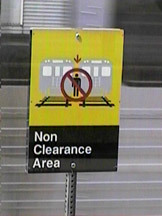 People from out of town will have no trouble finding the subway; virtually all bus, streetcar and intercity rail routes feed and are fed by the subway system. Luckily for the organization of this article, Toronto has one of the most easily explained subway systems in the world. Toronto has two primary subway lines, if we exclude the Scarborough RT line (which we do, for it is above ground and useless). The Bloor-Danforth line (aka the green line) runs west-east, while the Yonge-University-Spadina line (aka the yellow line) runs north-south in a U shape. For organizational purposes, I'll consider the Yonge line separately from the University-Spadina line, and offer a tunnel-based tour of each of the three segments.
People from out of town will have no trouble finding the subway; virtually all bus, streetcar and intercity rail routes feed and are fed by the subway system. Luckily for the organization of this article, Toronto has one of the most easily explained subway systems in the world. Toronto has two primary subway lines, if we exclude the Scarborough RT line (which we do, for it is above ground and useless). The Bloor-Danforth line (aka the green line) runs west-east, while the Yonge-University-Spadina line (aka the yellow line) runs north-south in a U shape. For organizational purposes, I'll consider the Yonge line separately from the University-Spadina line, and offer a tunnel-based tour of each of the three segments.
I don't recommend touring the tunnels of the entire line on foot, as traveling the entire 62.8-kilometer route takes almost four hours by subway. Be very selective and view only those areas that offer a risk-to-thrill ratio you're comfortable with.
Entering the Subway Tunnels
Making the first plunge beyond the "Danger: Do Not Enter" gates is probably the biggest step in beginning one's journey into the world of the subway tunnels. The short stainless-steel gates are located at either end of every subway platform. Security cameras monitor many of the platforms, so be sure to have a good look around for any security cameras before you start fiddling with the gate. You also have the option of viewing the security monitors inside the collector's booth to see exactly what the collector can see. The gates may seem locked when you first try them, but they don't actually have locks. The doors to the gates must be pulled upwards and then pushed. (I learned this trick when I was eight, at an Ontario Science Centre display called The Garden Gate. I knew science would come in handy one day.)
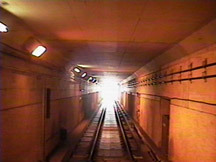 |
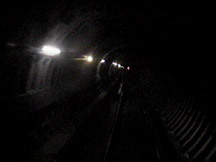 |
Top: Square tunnels.
Bottom: Not.
|
Naturally the best time to enter the tunnels is when the subway is least populated, late on weeknights and early on weekend mornings. Subway service starts around 6AM every morning (except Sundays when it starts around 9AM), and ends around 1:30AM every night. It is possible to continue exploring after 1:30AM during the brief four-hour interval when the subways sleep, but this is much more dangerous since one can no longer use the station platforms as a safe homebase. Security staff stay on duty after closing, and even after all the passenger trains have finished their runs and returned to the shipyards, the tunnels may still be populated by a variety of maintenance vehicles, including a vacuum car and two tunnel-washer cars.
Before we begin our excursion, a few terms require clarification. By "square tunnels," I mean cut and cover tunnels, which are constructed by crews digging down to the required depth, laying the tracks, and then covering up the hole. Square tunnels are fairly wide and boxy, and usually have holes in the concrete walls, which allow an explorer to jump from one set of tracks to the other. By "tube tunnels," I refer to bored-out tunnels, which are constructed by sending a huge digging machine along underground and then reinforcing the tunnels it digs with metal tubes. Tube tunnels offer no way to travel between parallel tunnels and are tighter spaces than square tunnels, allowing just barely enough room for a human to press up against the wall and let a train whip past. By "third rail," I refer to the electrified rail, which runs alongside the two standard train tracks. This third rail is covered with boards, but you should still stay well clear of it at all times, since it has enough current to kill you, and the last thing I need is some subway inspector finding a fried corpse lying across the tracks with its charred hand grasping a smoking copy of Infiltration 5.
South on the University-Spadina Line
Beginning at the end, our tunnel tour commences at the newest station on the line. Downsview station was constructed in 1996, and it is the prettiest station in Toronto. Its tunnels are also quite easy on the eye, not yet having acquired a full coating of soot. Highlights at Downsview include the great trail tracks (tracks that go beyond the end of the line), ventilation rooms, and an unusual area between the two tunnels just south of the station. It looks like the TTC was going to build a third set of tracks here but changed their minds. The ridiculously clean tunnels continue for quite some way, but there's no point in trying to follow the tracks to Wilson, as there are extended stretches where the tracks run outside.
Leaving Downsview, one enters the original section of the Spadina line, which went into service in 1978. The stations all have a mellow 70s feel to them, and browns, beiges and oranges are popular. In a startling contrast to Downsview, Wilson is the ugliest and worst-planned station on the line, decorated with brownish-yellow paint and artificial plants, which inspire deep feelings of pity. Although Wilson has an outdoor train yard, which probably has places to explore, the station is just such a huge, sprawling mess that I'd rather not talk about it anymore.
Continuing south, the route from Wilson to Eglinton West is boring and outside for the most part. The tunnels between Eglinton West, St. Clair West and Dupont are long, curvy deathtraps which alternate between square and tube tunnels and offer no great rewards, aside from a fair number of emergency exits.
Continuing south from Dupont, one comes to the station for which the Spadina line was named. I speak, of course, of Spadina station (!). Spadina's a bit confusing, though this doesn't make it any less lovable. Y'see, Spadina is really two stations, one on the north-south University-Spadina line, and one on the west-east Bloor-Danforth line. It's said that early plans for the Spadina extension did not show a north-south portion of Spadina station, but rather a separate station called Lowther (after a minor street nearby). In the end, however, the TTC decided to pretend the two stations were one so they could employ a single collector. Let us not heap scorn upon the TTC for this cheapness, however, for it is this odd arrangement which brought us the wondrous moving sidewalks between the two sections. (I could go on for hours about all the neat games you can play on Spadina's moving sidewalks, but alas, such information lies outside the scope of this article.)
Next up is St. George, a standard two-level station with one center platform over another, and one of the busiest stations on the line. I don't know of any tourist attractions here. South of St. George station, the University-Spadina line starts following University Avenue. This section was completely tunneled and finished in 1963.
First up is the hidden treasure that is Museum station. Museum has the lowest incidence of crime on the rapid transit system, and perhaps for this reason the platform is ineffectively monitored by a single camera and seems pretty much ignored by security. This lack of security makes it very easy to get into the tunnels and discover an abandoned subway station, as described later in this article.
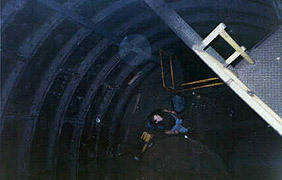 Those who want to spend as little time in the tunnels as possible should turn their attention to the southern end of the University line, where the distance between stations is so minuscule one wonders why the TTC didn't just install moving sidewalks. Osgoode is only a quick five-minute stroll through the tubes south of St. Patrick, though there are all sorts of fascinating mechanical rooms and ventilation chambers along the way, and visiting these may make the trip considerably longer. At 380 meters, the tunnels between Osgoode and St. Andrew are the shortest on the transit system, and are therefore ideal for those who just want to quickly run between two stations and be done with it.
Those who want to spend as little time in the tunnels as possible should turn their attention to the southern end of the University line, where the distance between stations is so minuscule one wonders why the TTC didn't just install moving sidewalks. Osgoode is only a quick five-minute stroll through the tubes south of St. Patrick, though there are all sorts of fascinating mechanical rooms and ventilation chambers along the way, and visiting these may make the trip considerably longer. At 380 meters, the tunnels between Osgoode and St. Andrew are the shortest on the transit system, and are therefore ideal for those who just want to quickly run between two stations and be done with it.
South of St. Andrew, the tunnels take a sharp eastward turn towards Union, ending our tour of the University-Spadina line.
North on the Yonge Line
When the first phase of Toronto's subway opened on March 30, 1954, passengers could ride 7.4 kilometers from Union Station to Eglinton for a mere 15 cents. Most of the stations between Union and Eglinton have since suffered some renovating and remodeling, but the tunnels still retain most of their original decor.
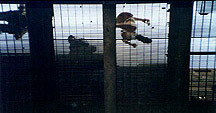 The tunnels between Union and King are the oldest stretch of subway tunnels in Toronto, which makes them distinctly tempting, but the square-cut tunnels in this area are too curvy, narrow and dimly-lit to be safe. There also seems to be a distinct shortage of hiding places. The tracks from King up to Wellesley are a better bet; the tunnels are short and it's easy to find somewhere to hide when you need to. These tunnels also lead to ventilation shafts, which look out onto Yonge Street, which is quite cool. After climbing a ladder up from the tunnels to get into the ventilation shaft just south of College station, Ultraviolet and I had the unique experience of watching the Gay Pride parade from underneath.
The tunnels between Union and King are the oldest stretch of subway tunnels in Toronto, which makes them distinctly tempting, but the square-cut tunnels in this area are too curvy, narrow and dimly-lit to be safe. There also seems to be a distinct shortage of hiding places. The tracks from King up to Wellesley are a better bet; the tunnels are short and it's easy to find somewhere to hide when you need to. These tunnels also lead to ventilation shafts, which look out onto Yonge Street, which is quite cool. After climbing a ladder up from the tunnels to get into the ventilation shaft just south of College station, Ultraviolet and I had the unique experience of watching the Gay Pride parade from underneath.
The beautiful Bloor Station is the second busiest station on the line, with 165,000 passengers passing through each day. Bloor rests atop Yonge in the same way that Upper St. George and Upper Bay rest atop their lower counterparts. Yonge/Bloor is the only single station with two names, though this is the standard practice in New York. There are almost certainly some nice sights in the area just south of Bloor, but unfortunately it would be basically impossible to enter the tunnels unseen. The area just north of Bloor is less tempting, as the tracks head outside almost immediately.
The route between Bloor and Eglinton is mostly outside and skippable, but the tunnels between Summerhill and St. Clair are underground and unique. The northbound and southbound tracks run alongside each other in what can best be described as a very wide, open trench with steep-sloping sides. There are no walls between the two tracks. A few large machines and power boxes offer the only potential hiding places along the long route, though there are one or two rather interesting-looking nooks just south of St. Clair which one could dive into. It seems to be a dangerous route, in terms of being seen, but certainly a tempting one.
Eglinton was the original terminus of the northbound Yonge line, and it has the track setup to prove it. The area just to the north of Eglinton offers some interesting exploration opportunities. The area to the south must be especially dangerous for some reason because the tunnel walls are lined with "Keep Off" and "Danger" signs which make it impossible to walk along the trackside ledge. Of course, there's no reason to head south from Eglinton anyhow, since the tracks head outside almost immediately.
So concludes the original portion of the Yonge subway line. In 1973 the Yonge line was extended to York Mills and then to Finch a year later. North York Centre Station was added between Sheppard and Finch in 1987. I don't recommend tunnel running between stations anywhere in this new area, as most of the tunnels are very long tubes which offer very few places to hide or escape. This is not to say that there's nothing to see, of course. The new section of the Yonge line appears to have been built by construction workers who had difficulty finding good daycare for their children; all the new stations have large, open playgrounds filled with ladders, machines, and similar toys just north of their "Danger: Do Not Enter" gates.
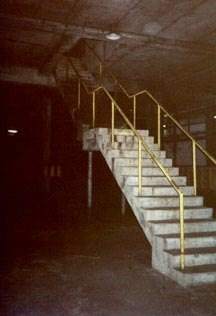 The most interesting area on the entire rapid transit system has to be the transit playground just to the north of Lawrence station. Between the two tube tunnels lies a dark, wide area filled with electronics, machinery and other such delights, but the most conspicuous feature is the stairway leading two storeys up and through a hole in the cement roof. At the top of the stairs lies a huge, dark, bizarre "attic" to the station, containing many smaller rooms, ladders leading down to ventilation shafts and up to a street level grate in the middle of Yonge Street, overhangs where one can watch the subway pass underneath, and so much more. This area has a very tall ceiling and is as long and wide as soccer field, and it's simply breathtaking to behold. I really have to insist that you check it out.
The most interesting area on the entire rapid transit system has to be the transit playground just to the north of Lawrence station. Between the two tube tunnels lies a dark, wide area filled with electronics, machinery and other such delights, but the most conspicuous feature is the stairway leading two storeys up and through a hole in the cement roof. At the top of the stairs lies a huge, dark, bizarre "attic" to the station, containing many smaller rooms, ladders leading down to ventilation shafts and up to a street level grate in the middle of Yonge Street, overhangs where one can watch the subway pass underneath, and so much more. This area has a very tall ceiling and is as long and wide as soccer field, and it's simply breathtaking to behold. I really have to insist that you check it out.
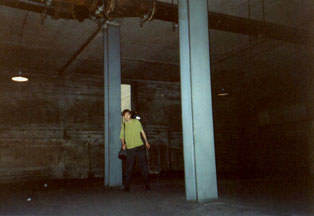
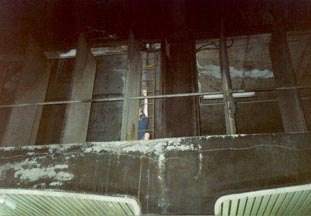
Just north of Lawrence station, yellow stairs lead up to a
soccer-field sized attic with all sorts of dark nooks and crannies to explore.
At the southernmost end of the Lawrence attic, my associate Sean descended a ladder leading a couple storeys down into what I had foolishly dismissed as a standard-issue ventilation shaft. When he reemerged 10 minutes later with a huge grin on his face, I knew there was something more to it. The ventilation shaft leads to an overhanging balcony from which one can observe the action on the Lawrence platform (and from which the people on the escalators can see you, so be careful). As if this wasn't enough, corridors shoot off south leading to still more mysterious, high-ceilinged tunnels and chambers. There is no artificial light in this area and we were sadly unarmed with flashlights at the time, so I was only able to get a glimmer of the immenseness that lay beyond. Vive Lawrence! Vive Life!
York Mills, Sheppard and North York Centre have similar playgrounds located just north of their "Danger: Do Not Enter" gates, but they lack anything so thrilling as Lawrence's gigantic attic. Finch's northern playground offers a brightly-lit series of three tail tracks, various small maintenance rooms, a ladder leading down to some very foul-smelling sewers, and ladders leading up to ventilation rooms on either side of the station. This is a fairly nice area to hang around in, though unfortunately it's a fairly heavily staffed station. For now, Finch is the end of the Yonge line.
West on the Bloor-Danforth Line
Generally speaking, the Bloor-Danforth line gets more and more modern and less and less interesting the further one gets from its centre. Kipling, at the westernmost end of the line, is pathetic and boring. Its tiny little tail tracks are outside, of all places, and extremely unimpressive. The situation does not improve much as one travels east past Islington, Royal York, Old Mill, Jane, Runnymede and High Park; there's nothing special to see in these stations or their tunnels and the tracks often run outside for long stretches. Icky.

I ducked into this St. Georgian crawlspace for a minute while two trains passed simultaneously.
Continuing east, one reaches the original section of the Bloor-Danforth line, which was completed in 1966 and runs from Keele to Woodbine. As the original western terminus of the line, Keele has a distinctive track setup including sidetracks leading off to a repair yard. Unfortunately, it is not until Dundas West that the tracks go back underground where they belong and stay there, and not until Bathurst that we come to the truly fun section of the Bloor-Danforth line. At Bathurst there is a nice little overhang above the tracks that's worth investigating.
Next on the line is the Bloor-Danforth segment of Spadina, where the doors beyond the gates are nicely unlocked. The security cameras are very poorly arranged here so it's easy to go through the gates unseen. In the tunnels, one can find several maintenance rooms, escalator rooms, and even climb down long metal ladders into the storm sewers. Lots of fun. After Spadina comes the equally delightful Lower St. George. The area just to the west of the station offers a plethora of unlit cubbyholes and crawlspaces, as well as a very long metal ladder which ascends many meters up to street level and a small pitch-black loft containing two huge fans. Just to the east of Lower St. George, one has the option of the following the tracks east to Upper Bay or southeast to Museum.
Only the upper part of Bay station is in regular use today, though Lower Bay is still quite accessible to anyone willing to take a quick stroll through the tunnels heading west from Yonge or northeast from Museum. It's a relatively little known fact that Museum, St. George and Lower Bay stations are connected in a Y-shape. The route along the disused tunnel from Museum down to Lower Bay is one of the most exhilarating and rewarding exploration sites in the system. Museum is one of the least used stations, and the gates are not monitored at all, so it didn't take much effort for my two comrades and I to scurry beyond the gates and into the tunnels. The three of us then intrepidly hiked down the curvy centre tunnel towards the legendary Lower Bay station, striding along the small trackside ledge as fast as we dared to travel while keeping a careful eye on the electrified third rail. This graffiti-decorated tunnel is no longer in regular use, but the tracks are still powered for those special occasions when trains need to switch from one line to other. Fortunately, no trains needed to switch lines during our 20-minute descent, though this didn't prevent us from becoming extremely frightened each time a train roared through the tunnels around us. Along the way, we found ladders up four storeys up to the surface and a single storey down into the sewers. We were grateful whenever we found some dark corridor, maintenance area or ventilation room where we could stop and calm ourselves for a moment or two.
[My updated thoughts: The journey to Lower Bay is actually quite dangerous. Though the tunnels leading to Lower Bay are no longer in constant use, they are frequently used by trains switching lines, or by drivers in training. If a train came along at full speed while you were on your way to Lower Bay, you would almost certainly be killed. As far as I know there is no way to get to Lower Bay through the tunnels during operating hours without risking your life. I don't make the trip anymore, and I don't recommend it to others. There are other ways to get to Lower Bay (after hours, on a tour, during a film shoot), and there are other amazing places to sneak into in the subway system. --Ninj]
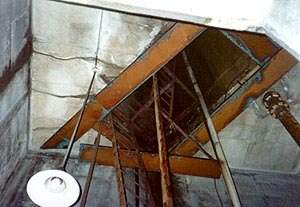
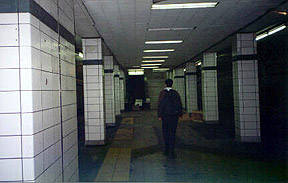
Ladders down to the sewers and four storeys up to the surface break up
the long curvy trek from Museum to the abandoned Lower Bay station.
When we finally glimpsed the abandoned station's white tiles just around the corner, our hearts pounded. The legend was real. Forcing ourselves to remain quiet, we slowly inspected the platform for signs of cameras or motion detectors. Finding none, we carefully ventured forth. After we'd looked about breathlessly for a couple of minutes we heard voices and scurried back into the tunnels in a panic before realizing that the voices were simply carrying down through the ventilation shafts from Upper Bay. After this we explored in relative peace, and were amazed and delighted at all the machinery, filth, and leftovers from old movie sets lying about the platform.
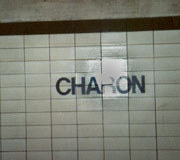 |
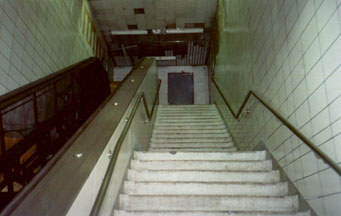 |
| Once upon a time, some movie set decorated Lower Bay as "Charon" station. |
When we'd had enough, we ascended a staircase, which we figured would lead to Upper Bay. Bracing ourselves, we strolled out through the automatically locking door into Upper Bay like it was the most natural thing in the world, which indeed it was. As Sean saw it, if anyone gave us a funny look we could simply complain, "We waited down there for over an hour and the train never came."
The tunnels between Bay and Yonge are a great place to go tunnel running, as there are many neat rooms, turnoffs, and hiding places in a single short stretch. The only problem is emerging into Yonge. Yonge is Toronto's busiest station with over 170,000 riders passing through daily, and it's never pleasant to face several thousand aghast faces as one emerges from the tunnels. Tunneling is kind of like flying in an airplane - the take off and the landing are usually the scariest parts. As usual, the important thing to remember is that you are supposed to be there. (I authorized you back in issue two, remember?)
Continuing eastward through the curvy tube tunnels near Sherbourne and the sunroofed tunnels near Castle Frank, we eventually come to one of the line's most fascinating and challenging stretches of track. Between Castle Frank and Broadview stations, the trains depart the tunnels and speed along the wide expanse of the Prince Edward Viaduct. For those unfamiliar with this feat of modern engineering, the viaduct is the immense steel-arch bridge, which spans the Don Valley, rising high above the Don Valley and the Rosedale Ravine, and supporting both Bloor Street and the subway line. Those who enjoyed Stand By Me will love this trip: the distance between one side of the bridge and the other is over half a kilometer!
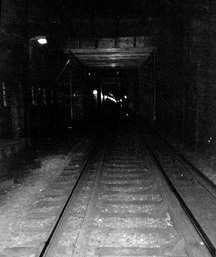 When Ultraviolet and I took first our timid steps through the tunnels from Broadview and out onto the bridge late one night, the 78-year-old viaduct was in the midst of a major facelift. Clear but muddy tarpaulins were wrapped around the sides, impeding our view of the Don Valley Parkway far beneath us. Dirt was everywhere, and the tunnels were filled with the thunderous noise of cars and trucks driving along Bloor Street above us. Because of the noise, we didn't get much warning when a train came racing down the tracks. Not having time to find a proper hiding place, we quickly hurtled ourselves over a cement wall and slid down into a huge, steep pit of dirt located between the tracks. This extremely wide and deep pit seemed somehow related to the construction, and provided good cover while the train passed overhead. By the time we'd managed to re-scale the pit's steep wall and run back through the tunnels to Broadview, we were absolutely covered in grease and dirt and our shoes were filled with sand. It was a triumph.
When Ultraviolet and I took first our timid steps through the tunnels from Broadview and out onto the bridge late one night, the 78-year-old viaduct was in the midst of a major facelift. Clear but muddy tarpaulins were wrapped around the sides, impeding our view of the Don Valley Parkway far beneath us. Dirt was everywhere, and the tunnels were filled with the thunderous noise of cars and trucks driving along Bloor Street above us. Because of the noise, we didn't get much warning when a train came racing down the tracks. Not having time to find a proper hiding place, we quickly hurtled ourselves over a cement wall and slid down into a huge, steep pit of dirt located between the tracks. This extremely wide and deep pit seemed somehow related to the construction, and provided good cover while the train passed overhead. By the time we'd managed to re-scale the pit's steep wall and run back through the tunnels to Broadview, we were absolutely covered in grease and dirt and our shoes were filled with sand. It was a triumph.
Compared to that, the short, square tunnels between Broadview and Main Street seem distinctly uninteresting, though there are some appealing sidetracks between Donlands and Greenwood that would be worth a look sometime. Presumably these head south towards the Greenwood train yard.
From Main Street eastward, tunneling is no longer a very attractive option. The routes from Main Street to Victoria Park and from Victoria Park to Warden are long and outside. The tunnels between Warden and Kennedy span the longest route on the subway line, a route almost as long as the entire University line. There are two emergency exits along the route. In my opinion, walking the full 2.7 kilometers between these two easternmost stations would be more of an endurance test than an adventure, though I'd certainly have to respect anyone with enough determination to attempt such a trip.
Kennedy station is fairly awesome; a metal ladders leads up over the office to a series of metal catwalks linked by stairs and ladders, eventually leading through some cement air ducts to a grate at street level. Unfortunately, this is the most heavily staffed part of the station.
So concludes our journey. I hope you survived, and I promise we'll do something nice and safe and above ground next issue.
This article originally appeared in Infiltration 5, together with articles on exploring the underground LRT stations (Union, Queens Quay and Spadina) and the abandoned subway stations (Lower Bay and Lower Queen).
|

